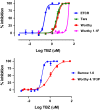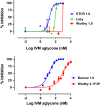Multiple drug resistance in the canine hookworm Ancylostoma caninum: an emerging threat?
- PMID: 31818311
- PMCID: PMC6902405
- DOI: 10.1186/s13071-019-3828-6
Multiple drug resistance in the canine hookworm Ancylostoma caninum: an emerging threat?
Abstract
Background: The canine hookworm, Ancylostoma caninum is the most prevalent and important intestinal nematode parasite of dogs in the USA. Hookworms are typically well controlled by treatment with all commonly used anthelmintics that are approved for this use in dogs. However, in the past few years, cases of recurrent/persistent canine hookworm infections appear to have dramatically increased, suggesting that anthelmintic resistance (AR) may have evolved in this parasite. These cases are highly overrepresented by greyhounds, but multiple other breeds are also represented. The aim of this study was to characterize several of these suspected resistant isolates using in vitro, genetic and clinical testing to determine if these cases represent true anthelmintic resistance in A. caninum.
Methods: Fecal samples containing hookworm eggs from three cases of persistent hookworm infections; one from a greyhound, one from a miniature schnauzer and one from a hound-mix, were received by our laboratory. These were then used to establish infections in laboratory dogs and to perform egg hatch assays (EHA) and larval development assays (LDA) for detecting resistance to benzimidazoles and macrocyclic lactones, respectively. Additional EHA and LDA were performed on eggs recovered from the laboratory-induced infections. Fecal egg count reduction tests were performed to detect resistance to pyrantel. Deep amplicon sequencing assays were developed to measure the frequency of non-synonymous single nucleotide polymorphisms (SNP) at codons 167, 198 and 200 of the A. caninum isotype-1 β-tubulin gene.
Results: Resistance ratios for the three A. caninum isolates tested ranged from 6.0 to > 100 and 5.5 to 69.8 for the EHA and LDA, respectively. Following treatment with pyrantel, reduction in faecal egg counts was negative or 0%. Deep amplicon sequencing of the isotype-1 β-tubulin gene identified a high frequency of resistance-associated SNPs at codon 167 in all three resistant isolates and in two additional clinical cases.
Conclusions: These data conclusively demonstrate multiple anthelmintic resistance in multiple independent isolates of A. caninum, strongly suggesting that this is an emerging problem in the USA. Furthermore, evidence suggest that these resistant hookworms originate from racing greyhound farms and kennels, though additional research is needed to confirm this.
Keywords: Ancylostoma caninum; Anthelmintics; Canine health; Hookworms; Resistance.
Conflict of interest statement
The authors declare that they have no competing interests.
Figures




Similar articles
-
Multiple drug resistance in hookworms infecting greyhound dogs in the USA.Int J Parasitol Drugs Drug Resist. 2021 Dec;17:107-117. doi: 10.1016/j.ijpddr.2021.08.005. Epub 2021 Sep 2. Int J Parasitol Drugs Drug Resist. 2021. PMID: 34492564 Free PMC article.
-
Application of in vitro anthelmintic sensitivity assays to canine parasitology: detecting resistance to pyrantel in Ancylostoma caninum.Vet Parasitol. 2008 Apr 15;152(3-4):284-93. doi: 10.1016/j.vetpar.2007.12.020. Epub 2008 Feb 1. Vet Parasitol. 2008. PMID: 18242867
-
Multiple anthelmintic drug resistance in the canine hookworm Ancylostoma caninum: AAVP position paper and research needs.Vet Parasitol. 2025 Aug;338:110536. doi: 10.1016/j.vetpar.2025.110536. Epub 2025 Jun 28. Vet Parasitol. 2025. PMID: 40596793 Review.
-
Widespread occurrence of benzimidazole resistance single nucleotide polymorphisms in the canine hookworm, Ancylostoma caninum, in Australia.Int J Parasitol. 2025 Mar;55(3-4):173-182. doi: 10.1016/j.ijpara.2024.12.001. Epub 2024 Dec 22. Int J Parasitol. 2025. PMID: 39716589
-
Reflecting on the past and fast forwarding to present day anthelmintic resistant Ancylostoma caninum-A critical issue we neglected to forecast.Int J Parasitol Drugs Drug Resist. 2023 Aug;22:36-43. doi: 10.1016/j.ijpddr.2023.04.003. Epub 2023 May 10. Int J Parasitol Drugs Drug Resist. 2023. PMID: 37229949 Free PMC article. Review.
Cited by
-
Development of a New LAMP Assay for the Detection of Ancylostoma caninum DNA (Copro-LAMPAc) in Dog Fecal Samples.Front Vet Sci. 2021 Nov 12;8:770508. doi: 10.3389/fvets.2021.770508. eCollection 2021. Front Vet Sci. 2021. PMID: 34869740 Free PMC article.
-
Anthelmintic Potential of Medicinal Plants against Ancylostoma caninum.Vet Med Int. 2021 Nov 28;2021:3879099. doi: 10.1155/2021/3879099. eCollection 2021. Vet Med Int. 2021. PMID: 34876973 Free PMC article. Review.
-
Promoting veterinary medication safety - Exploring the competencies of community pharmacy professionals in veterinary pharmacotherapy.Vet Anim Sci. 2023 Aug 19;21:100310. doi: 10.1016/j.vas.2023.100310. eCollection 2023 Sep. Vet Anim Sci. 2023. PMID: 37664413 Free PMC article.
-
Efficacy of Anthelmintics Against Canine Hookworm Infections in the Bono East Region of Ghana.J Parasitol Res. 2025 Feb 19;2025:4079763. doi: 10.1155/japr/4079763. eCollection 2025. J Parasitol Res. 2025. PMID: 40017589 Free PMC article.
-
Differential Emodepside Efficacy in Drug-Resistant and Drug-Susceptible Ancylostoma caninum Highlights Variability in Potassium Channel Activity.Trop Med Infect Dis. 2025 Jun 27;10(7):181. doi: 10.3390/tropicalmed10070181. Trop Med Infect Dis. 2025. PMID: 40711058 Free PMC article.
References
-
- FDA. NADA 141-007 Drontal Plus. Silver Spring: Food and Drug Administration; 1994. https://animaldrugsatfda.fda.gov/adafda/views/#/foiDrugSummaries#foiAppl....
-
- FDA. NADA 141-251 Advantage Multi. Silver Spring: Food and Drug Administration; 2006. https://animaldrugsatfda.fda.gov/adafda/views/#/foiDrugSummaries#foiAppl....
-
- FDA. NADA 141-338 Interceptor Plus. Silver Spring: Food and Drug Administration; 2012. https://animaldrugsatfda.fda.gov/adafda/views/#/foiDrugSummaries#foiAppl....
MeSH terms
Substances
LinkOut - more resources
Full Text Sources
Research Materials
Miscellaneous

